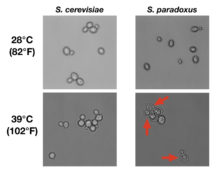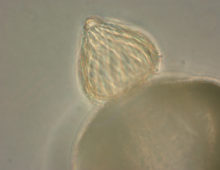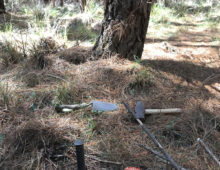Researchers build a genetic profile for a section of Aspergillus fungi. There are millions of fungal species, and those few hundred found in the Aspergillus genus play important roles in areas ranging from industrial production to agricultural plant pathogens. Reported October 22, 2018, in Nature Genetics, a team led by scientists at the Technical University…
Mining Metagenomes for Cas Proteins
Cas14 proteins discovered from JGI’s IMG/M database and biochemically characterized at UC Berkeley and the Innovative Genomics Institute. The Science Researchers report the discovery of miniature Clustered Regularly Interspaced Short Palindromic Repeats (CRISPR) associated proteins that can target single-stranded DNA (ssDNA). The discovery was made possible by mining the datasets in the Integrated Microbial Genomes…
Mapping Heat Resistance in Yeasts
A new approach for improving functional annotation in fungal genomes. The Science In a proof-of-concept study, researchers demonstrated that a new genetic mapping strategy called RH-Seq can identify genes that promote heat resistance in the brewer’s/baker’s yeast Saccharomyces cerevisiae, allowing this species to grow better than its closest relative S. paradoxus at high temperatures (39°C/102°F)….
Expanding Fungal Diversity, One Cell at a Time
Pilot study demonstrates single cell genomics approach for fungal genomic diversity. They can be found on forest floors, swamps and in houses, ranging in size from smaller than the period on your smartphone’s keyboard to stretching over several city blocks. More than a million species of fungi are estimated to live on this planet, but…
Adaptive Strategies of Bradyrhizobium
Soil microbial communities are among the richest sources of biodiversity on Earth. However, very little is known about the roles of individual microbial populations living in soil and how they affect important processes such as soil fertility and carbon cycling. This proposal investigates free-living Bradyrhizobium, an abundant and widespread soil bacterium, and will provide mechanistic…
Virus and Microbial Effects on Ocean Nutrient Cycling
Collected at the Southern Ocean Time Series, transcriptomes and manipulative experiments will establish virus and microbial processes that constrain the carbon cycle and system biogeochemistry (major DOE mission areas). Interactions on sinking particles, the specificity of virus-host relationships and trace metal effects will be examined. The cumulative data set will allow for the development of…
Regulating Water Use Efficiency Traits
Roots and stomata are plants’ primary entry and exit points for water. Therefore, they are key targets for manipulation to improve bioenergy crop productivity, resilience and sustainability by reducing the risk of crop losses due to inadequate water supply. The number of pores, called stomata, on the leaf surface influences how much water the crop…
Time-Series of Freshwater Lake Microbial Communities
Freshwater lakes contain diverse and dynamic microbial communities that play key roles in maintaining water quality, cycling nutrients, and regulating carbon uptake and storage. They are important hotspots for biogeochemical cycling in terrestrial landscapes. This project aims to use hundreds of samples collected over time in two very different lakes to understand how these communities…
EMF-Pine Co-Invasion in the Southern Hemisphere
Pine plantations in the Southern Hemisphere possess greatly impoverished assemblages of ectomycorrhizal fungi (EMF), often fewer than 20 species at a single forest site, compared to native populations of those same pines. The filtering results in a loss of some EMF lineages and may lead to large-scale impacts on soil biogeochemical processes. This work is…
Measuring mRNA Levels in Chlamydomonas
The analysis of gene expression allows scientists to generate hypotheses important for the understanding of gene function. Proteins that participate in similar functions, or form larger protein complexes, are often encoded by genes that share similar expression profiles. This type of analysis has been limited to “steady-state” mRNA levels, that is the combined output of…




